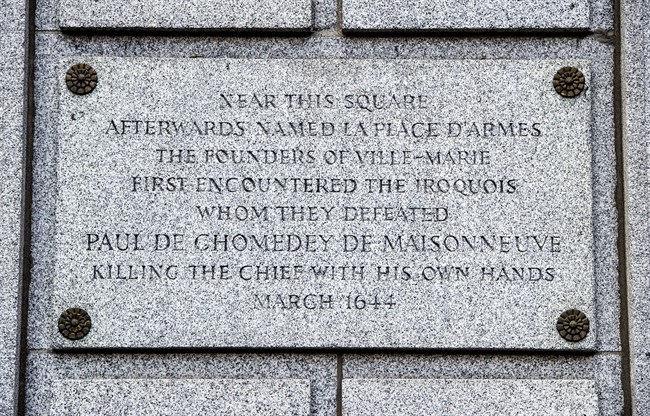Michael Rice said growing up as a Mohawk child, he was told to be prepared to come across portrayals of Indigenous people as the “bad guys.”

“We are used to being bashed as Iroquois,” the high school history teacher said in an interview. “We are like the Russians in the Cold War.”
An example of Iroquois bashing, he said, is the stone marker on the facade of the Bank of Montreal building in the city’s historic Place d’Armes square, one of Montreal’s top tourist destinations.
Across the street from a statue of the founder of Montreal, Paul de Chomedey, sieur de Maisonneuve, is an engraving dedicated to a man he killed in 1644.
“Near this square afterwards named La Place d’Armes the founders of Ville-Marie first encountered the Iroquois whom they defeated,” the marker reads.
“Paul de Chomedey de Maisonneuve killing the chief with his own hands. March 1644.”
A few feet away is a second stone marker with the same message in French.
READ MORE: Place D’Armes receives native American name to celebrate National Aboriginal Day
The Iroquois or Six Nations, form a confederacy consisting of the Seneca, Cayuga, Oneida, Onondaga, Mohawk and Tuscarora.
Rice, 48, who is from Kahnawake and now lives in Deux-Montagnes, Que., north of Montreal, said he first complained of the engravings to bank employees in 1992 but nothing came of it.
Twenty-five years later, a bank spokeswoman told The Canadian Press the stone markers are coming down.
Bank spokesman Valerie Doucet said in an email Quebec’s Culture Department has been notified.
“The department informed us that they would meet us soon,” Doucet said. “On our side, we have already obtained a submission from a specialized firm to remove and replace the two stones on which the text has been engraved.
READ MORE: Cross-Canada expedition reaches out to Montreal Mohawks
She said the Bank of Montreal building has been designated a heritage site in Old Montreal and therefore authorization is needed from the provincial government before work can begin to remove the marker.
“As soon as we get that authorization, we will go ahead,” Doucet said. “The text was engraved on the building’s stones before the Bank of Montreal acquired it in the early 1980s.”
City spokesman Marc-Andre Gosselin said the BMO building is a protected heritage site.
“This building is listed as historic and we are working with the Quebec government on this case and about how to proceed.”
Rice said he doesn’t want the markers removed.
READ MORE: Many indigenous people see little reason to celebrate Canada 150
Instead, he suggests another marker be added to the bank’s facade in order to show the aboriginal viewpoint.
“We need to put into context the fact that the Iroquois chief was defending his territory,” Rice said. “Depicting (the Iroquois) as fish waiting to be shot or as bloodthirsty Iroquois doesn’t do justice to history.”
Rice’s position highlights the ongoing debate in North America around whether statues and other historical symbols — deemed offensive by some — should be removed or preserved in order to stimulate discussion.
WATCH BELOW: Cornwallis dispute continues in Halifax
Halifax’s city council voted in April to convene an expert panel to recommend what to do about municipal landmarks paying tribute to Colonel Edward Cornwallis, who founded Halifax in 1749 and soon after issued a bounty on Mi’kmaq scalps in response to an attack on colonists.
The Mi’kmaq have long called for removal of tributes to Cornwallis, some calling his actions a form of genocide.
Rice said he wants the stone marker to stay in order to teach people about their history.
“If we want to have a genuine reconciliation, we need to have these opportunities to discuss,” he said. “We can’t change the past, but we can look back on it and learn from it.”
“Removing the (marker) is like trying to hide a scar. It’s a teachable moment and an opportunity.”










Comments